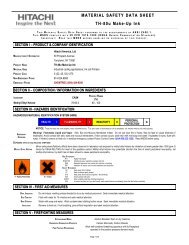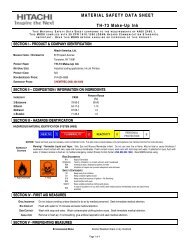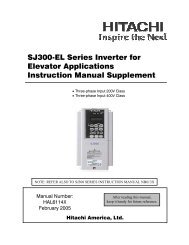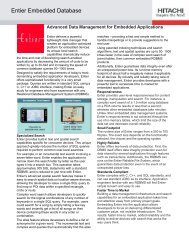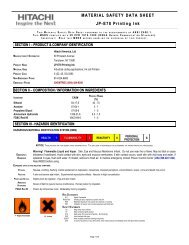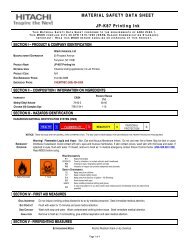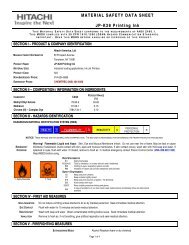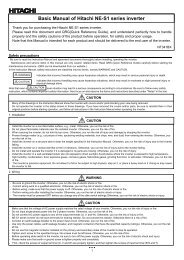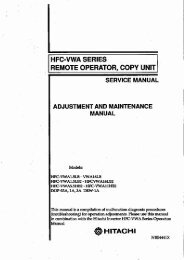SJ700-2 Instruction Manual NT204DX - Hitachi America, Ltd.
SJ700-2 Instruction Manual NT204DX - Hitachi America, Ltd.
SJ700-2 Instruction Manual NT204DX - Hitachi America, Ltd.
Create successful ePaper yourself
Turn your PDF publications into a flip-book with our unique Google optimized e-Paper software.
Chapter 4 Explanation of Functions<br />
(7) Output of inverted PID deviation<br />
If the inverter is under the normal PID control and the PID operation result is a negative value, the<br />
frequency command to the inverter will be limited to 0 Hz. However, when "02" (enabling the inverted<br />
output) is set for the PID Function Enable (A071), the PID operation result to be output to the inverter is<br />
inverted if the result is a negative value.<br />
Setting "02" for function "A071" disables the PID variation limit (A078) described above.<br />
(8) PID gain adjustment<br />
If the inverter response is unsteady when the PID control function is used, try to adjust gain settings as<br />
follows:<br />
- If the feedback data does not quickly follow the change in the target value → Increase the P gain (A072).<br />
- If the feedback data is unstable although it quickly follows the change in the target value → Reduce the<br />
P gain (A072).<br />
- If considerable time is required until the feedback data matches the target value → Reduce the I gain<br />
(A073).<br />
- If the feedback data fluctuates unsteadily → Increase the I gain (A073).<br />
- If the inverter response is slow even after the P gain is increased → Increase the D gain (A074).<br />
- If the feedback data becomes fluctuant and unsteady when the P gain is increased → Reduce the D gain<br />
(A074).<br />
(9) Maximum PID deviation output (OD)<br />
You can set the PID deviation level (C044) for PID control. When the PID deviation (ε) exceeds the level<br />
set as the level "C044", the signal is output to an intelligent output terminal.<br />
A value from 0 to 100 can be set as the level "C044". The range of values corresponds to the range of<br />
target values from 0 to the maximum.<br />
To use this output function, assign function "04" (OD) to one of the terminal functions C021 to C025 or the<br />
alarm relay terminal function C026.<br />
(10) Feedback comparison signal<br />
A feedback comparison signal can be output to an intelligent output terminal when the PID feedback data<br />
exceeds the specified range.<br />
To use this signal output function, assign function "31" (FBV) to one of the terminal functions C021 to C025<br />
or the alarm relay terminal function C026.<br />
C052 (off level)<br />
PID feedback<br />
C053 (on level)<br />
Time<br />
FW<br />
FBV<br />
ON<br />
OFF<br />
ON<br />
OFF<br />
(11) Process variable (PV), PID feedback monitoring (d004)<br />
You can monitor the PID feedback data on the inverter.<br />
When you set a PV scale conversion with function "A075", the value to be displayed as the monitored data<br />
can be the product of the feedback data and the scale.<br />
"Monitored value" = "feedback data (%)" x " PV scale conversion (A075)"<br />
(12) Reset of PID integration (PIDC)<br />
This reset function clears the integral result of PID operation.<br />
To use this function, assign function "24" (PIDC) to one of the terminal functions C001 to C008.<br />
The integral result is cleared each time the PIDC terminal is turned on.<br />
Never turn on the PIDC terminal during the PID operation. Otherwise, the inverter may trip because of<br />
overcurrent. Be sure to disable the PID function before turning on the PIDC terminal.<br />
4 - 29




